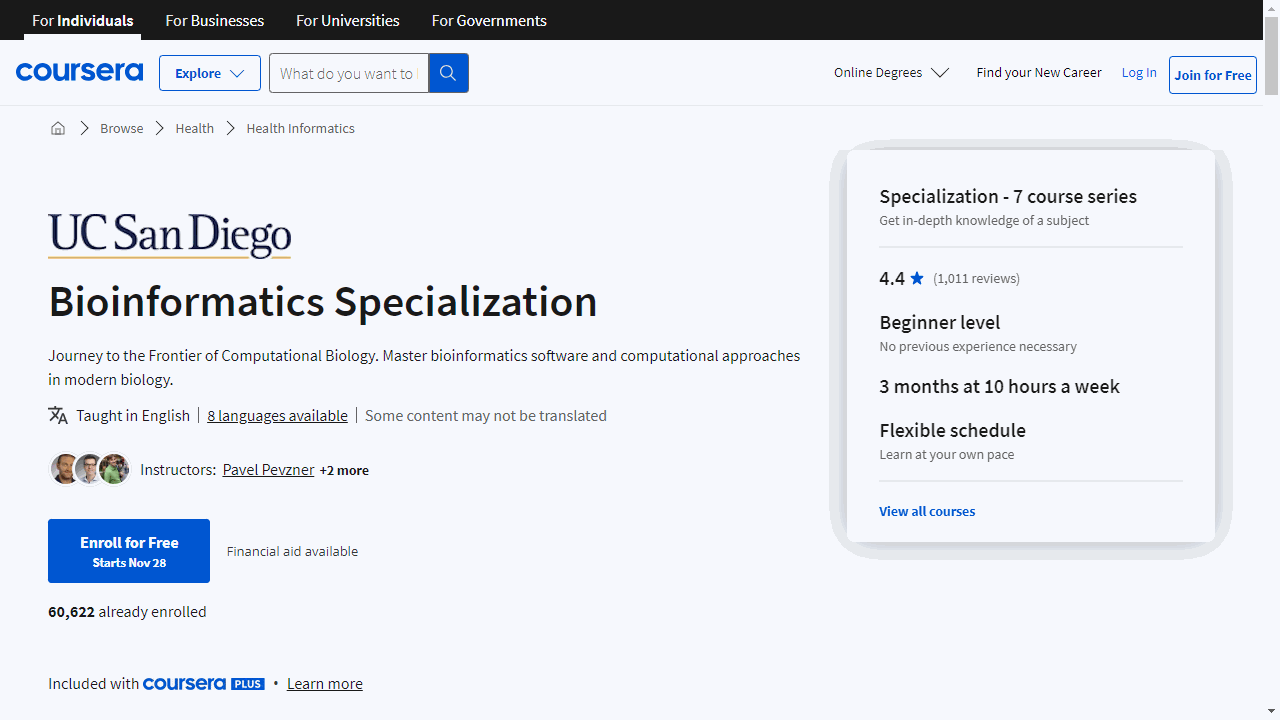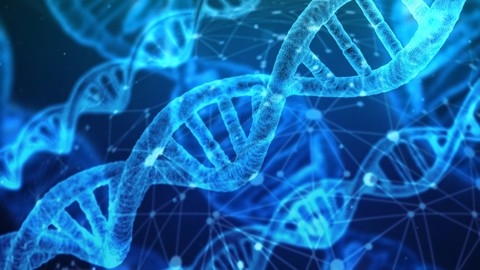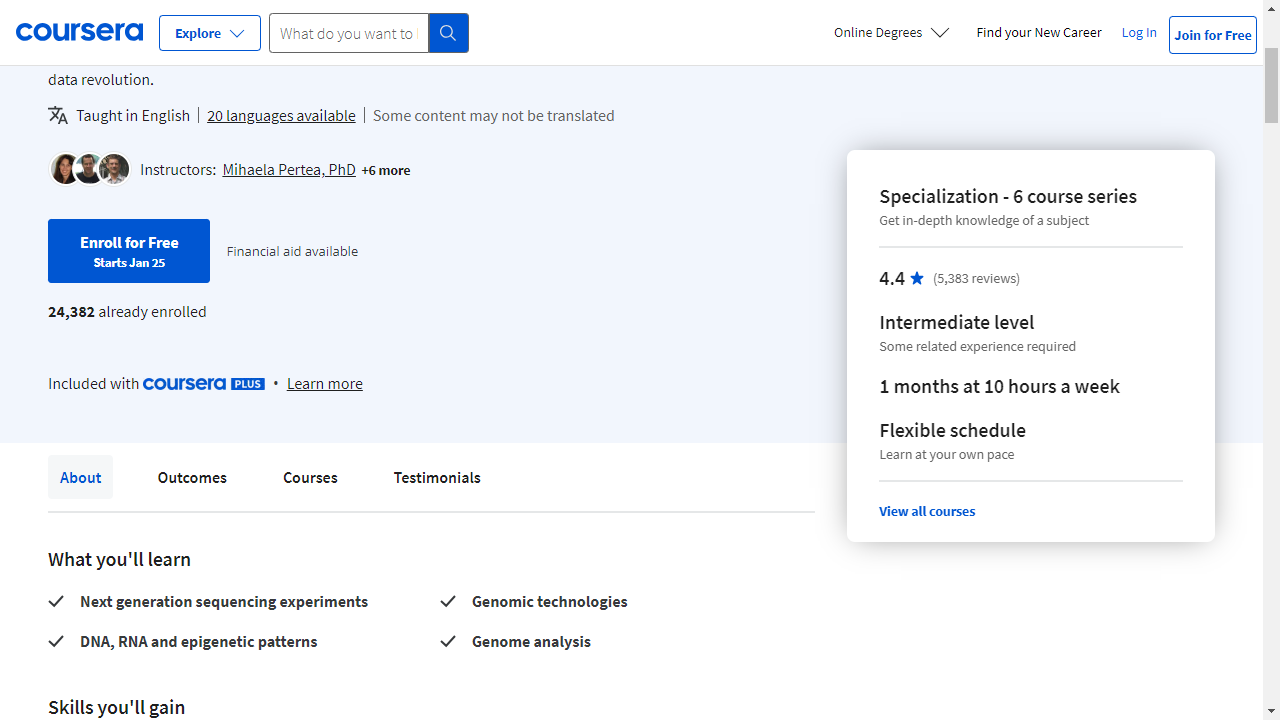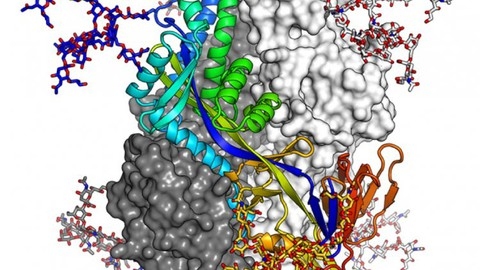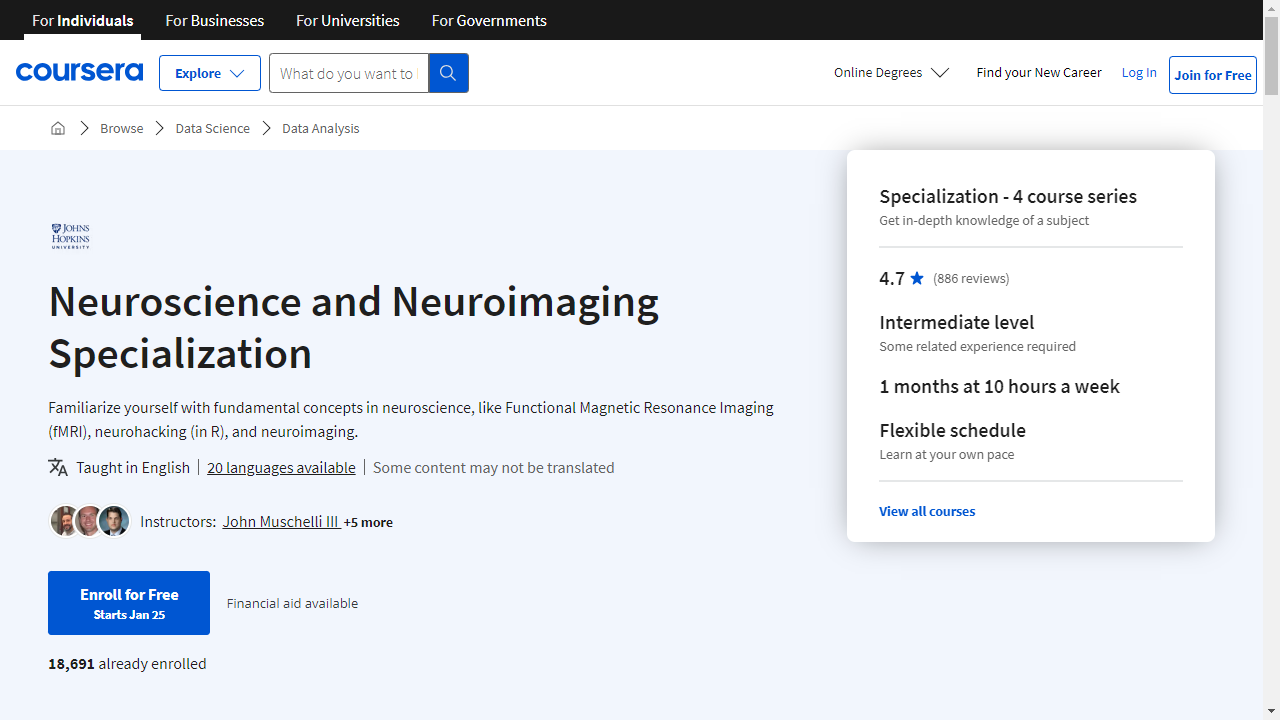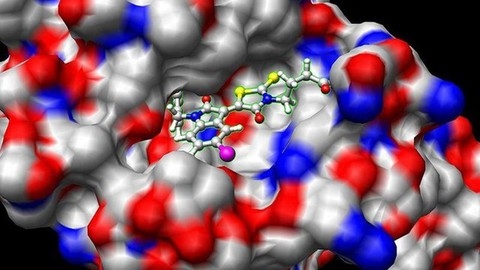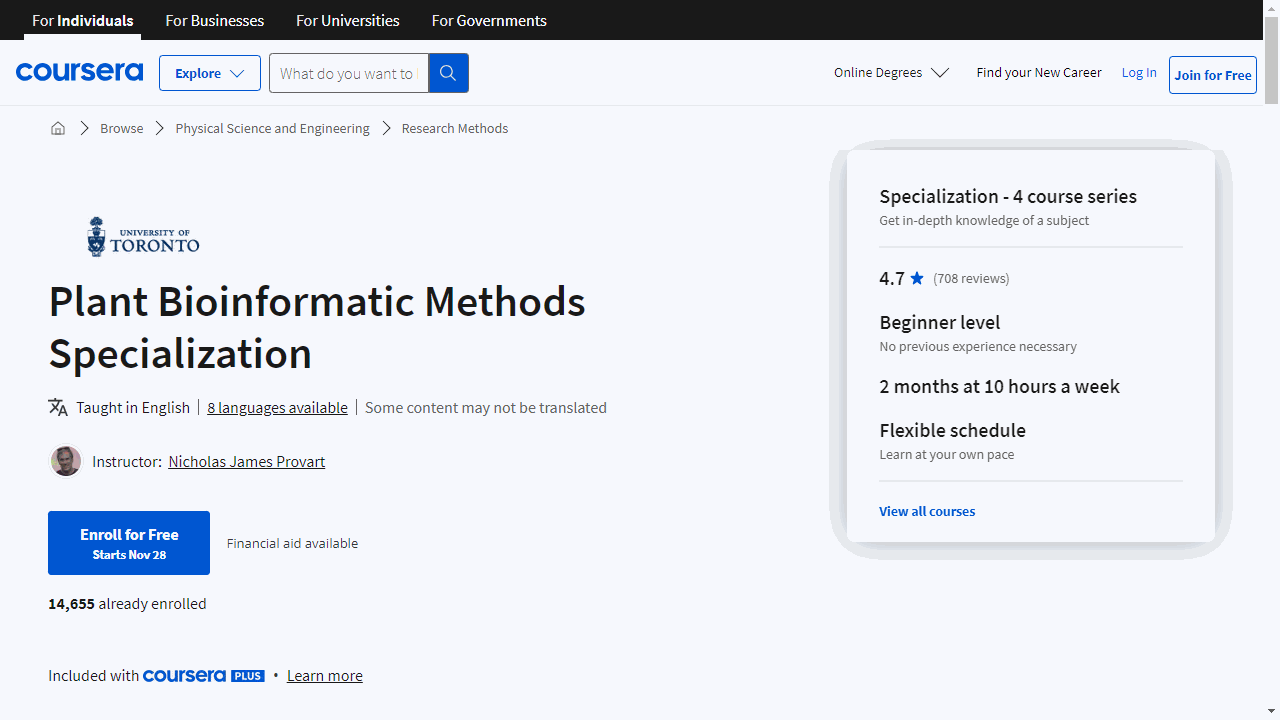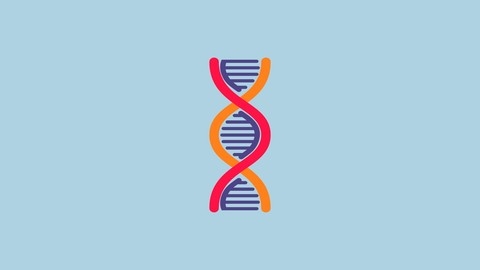Bioinformatics is a fascinating field that sits at the intersection of biology and computer science, applying computational techniques to analyze and interpret biological data.
From deciphering the secrets of DNA and genomes to understanding complex biological processes, bioinformatics plays a crucial role in modern biological research and healthcare.
By learning bioinformatics, you can unlock the power of big data in biology, gaining insights into everything from disease mechanisms to evolutionary relationships, ultimately contributing to advancements in fields like medicine, agriculture, and environmental science.
However, navigating the world of online learning to find the perfect bioinformatics course can be overwhelming.
With numerous options available, you need a course that not only covers the fundamental concepts but also provides hands-on experience with the tools and techniques used in real-world bioinformatics research.
You’re looking for a course that is comprehensive, engaging, and taught by experts who can guide you through the complexities of this dynamic field.
Based on our thorough analysis, the Bioinformatics Specialization offered on Coursera stands out as the best overall choice.
This specialization takes you on a comprehensive journey through the core concepts and applications of bioinformatics, from analyzing DNA sequences and genomes to using machine learning for biological discovery.
Taught by leading experts from the University of California, San Diego, this specialization combines engaging video lectures with practical exercises and real-world case studies, ensuring a deep and practical understanding of the field.
While the Bioinformatics Specialization is our top recommendation, there are several other excellent bioinformatics courses available, each with its own unique focus and strengths.
Whether you’re interested in specific areas like genomics, proteomics, or next-generation sequencing, or prefer a different learning platform like Udemy, we have curated a list of top-notch options to suit your needs and learning preferences.
So, keep reading to discover the perfect bioinformatics course to launch your journey into this exciting field!
Bioinformatics Specialization
Provider: Coursera
This specialization takes you on a journey through the fascinating world where biology meets computer science.
Imagine diving deep into DNA analysis, uncovering hidden messages within genetic codes.
You’ll learn how algorithms can pinpoint the start of DNA replication in bacteria and even decipher the mechanisms behind our daily rhythms.
You will analyze the genes of the bacterium Mycobacterium tuberculosis, understanding its ability to lie dormant for years.
Next, picture yourself tackling the massive task of genome sequencing, piecing together the intricate puzzle of an organism’s entire genetic blueprint.
You’ll learn how graph theory helps assemble genomes from fragmented DNA pieces and explore the world of antibiotics.
You will even sequence the genome of a Staphylococcus bacterium with antibiotic resistance, gaining valuable insights into fighting drug-resistant infections.
Prepare to compare genes, proteins, and entire genomes, tracing the evolution of different species.
You’ll learn powerful techniques like dynamic programming, which helps analyze mutations and understand the relationships between different organisms.
Imagine exploring the fascinating possibility of birds evolving from dinosaurs, using computational proteomics to analyze fossil proteins.
Then, you’ll uncover the power of algorithms and machine learning in analyzing genomic data.
Imagine using clustering techniques to understand how genes work together, identifying patterns in gene expression data, and even tracking ancient human migration patterns.
You’ll learn how to identify disease-causing mutations in DNA and proteins using sophisticated techniques like combinatorial pattern matching algorithms and hidden Markov models, particularly relevant in studying rapidly mutating viruses like HIV.
Finally, imagine putting all your newfound knowledge to the test.
You’ll use Illumina’s BaseSpace platform to work with real biological data, tackling real-world problems.
Imagine tracing the source of a food poisoning outbreak, analyzing gene expression in different tissues, and understanding the implications of whole-genome versus whole-exome sequencing.
You’ll even have the opportunity to build your own genome assembler, solidifying your expertise in the field.
Genetics and Next Generation Sequencing for Bioinformatics
Provider: Udemy
You’ll start with the fundamentals of DNA: its structure, how it’s coded, and how it’s used to make proteins.
The course dives into genes and chromosomes, explaining how genetic variations occur and are passed down.
It covers various inheritance patterns, including dominant and recessive alleles, codominance, and incomplete dominance.
Next, you’ll explore Next Generation Sequencing (NGS), a powerful technology that has revolutionized DNA sequencing.
You’ll learn how NGS compares to older methods like Sanger Sequencing, how it works step-by-step, and the importance of DNA libraries and adapters in the process.
The course explains different sequencing types, including paired-end sequencing, which provides a more complete view of DNA fragments.
You’ll also explore different types of genetic variants, including those linked to cancer, and see how NGS is used for personalized cancer treatment.
Finally, you’ll put your knowledge into practice by analyzing real NGS data using Galaxy, a popular bioinformatics platform.
You’ll learn about the FastQ data format, a standard for storing DNA sequence information.
Using tools like FastQC, you’ll assess the quality of your data and learn how to improve it with Trimmomatic.
This practical experience will solidify your understanding of NGS data analysis.
Genomic Data Science Specialization
Provider: Coursera
The Genomic Data Science Specialization, offered by Johns Hopkins University, provides a solid entry point into the world of bioinformatics.
You will begin by delving into the basics of genomics, including the Central Dogma of Molecular Biology, and exploring how next-generation sequencing technologies are used to examine DNA, RNA, and even epigenetic patterns.
The specialization then equips you with practical programming skills using Python and R, essential languages for bioinformatics.
You will learn to utilize powerful tools like Bioconductor and Samtools, gaining proficiency in analyzing large datasets with algorithms and data structures.
Command-line tools, crucial for managing extensive genomic datasets, are also covered.
Furthermore, this specialization emphasizes the importance of statistics in understanding genomic data.
You will explore biostatistics and data analysis techniques, enabling you to interpret results from popular genomic data science projects.
Upon completion, you will possess a robust understanding of bioinformatics concepts and skills, preparing you for a career in genomic research or data science.
Learn Bioinformatics From Scratch (Theory & Practical)
Provider: Udemy
This bioinformatics course takes you on a journey from the foundations of biological data to advanced analysis techniques.
You will begin by exploring biological databases like NCBI and PDB, mastering the ability to search and retrieve information.
You will then delve into the principles of sequence alignment, learning about global and local alignments and utilizing algorithms like Dot Matrix and Dynamic Programming.
You will gain hands-on experience with tools like EMBOSS and BLAST, enabling you to compare sequences and uncover evolutionary relationships.
The course then guides you through the world of genomic bioinformatics, teaching you how to predict genes and regulatory elements using algorithms like Markov Models.
You will apply these techniques to both prokaryotic and eukaryotic organisms, gaining insights into the complexities of DNA.
Next, you will explore the fascinating realm of structural bioinformatics, learning about protein structures, their stabilizing forces, and how to predict secondary structures using algorithms like GOR-IV.
You will also dive into 3D structure prediction, mastering tools like Modeller, I-TASSER, and even the cutting-edge AlphaFold.
Finally, you will explore evolutionary bioinformatics, learning how to construct and interpret phylogenetic trees to understand the evolutionary relationships between organisms.
You will become proficient in techniques like bootstrapping to validate your findings.
You can even choose to delve into additional modules covering docking analysis, Linux installation, and molecular dynamics simulations.
Neuroscience and Neuroimaging Specialization
Provider: Coursera
This specialization guides you through the fascinating world of neuroimaging, providing you with a solid foundation in this cutting-edge field.
You begin with “Fundamental Neuroscience for Neuroimaging,” covering the basics of neuroimaging methods used in research and clinical practice.
You delve into the history of neuroimaging, exploring different techniques like Diffusion Tensor Imaging and Magnetic Resonance Spectroscopy.
The course also introduces you to crucial neuroscience concepts, including the structure and function of the human brain, laying the groundwork for understanding how neuroimaging methods work.
Next, “Principles of fMRI 1” and “Principles of fMRI 2” take you deeper into the world of fMRI.
You learn how to design, acquire, and analyze fMRI data, covering important concepts like MR Physics and experimental design.
These courses equip you with the skills to process fMRI data, including pre-processing techniques, and introduce you to Generalized Linear Models (GLMs) used in fMRI data analysis.
Finally, “Introduction to Neurohacking In R” equips you with the valuable skill of using the R programming language for neuroimaging data analysis.
You learn how to manipulate, process, and visualize structural MRI data, mastering techniques like inhomogeneity correction and image registration.
Through this hands-on experience with the NIfTI format, you gain the ability to work with brain images directly, solidifying your expertise in neuroimaging data analysis.
Bioinformatics; Learn Docking & Mol Dynamics Simulation
Provider: Udemy
This bioinformatics course provides a deep dive into the world of molecular docking and molecular dynamics simulations.
You’ll begin by building a strong foundation in protein structure, understanding how to obtain 3D structures through both experimental methods and prediction tools like Modeller and I-TASSER.
The course then guides you through the theory and practical application of molecular dynamics simulations using GROMACS software on a Linux operating system.
You’ll learn how to install Linux on Windows, navigate the Linux terminal, prepare protein structures for simulations, and analyze simulation data.
This analysis includes calculating essential metrics like RMSD, RMSF, radius of gyration, hydrogen bonds, and solvent accessible surface area.
Next, you’ll delve into molecular docking, exploring various methods such as Vina, AutoDock4, and CB Dock, gaining a comprehensive understanding of scoring algorithms, sampling techniques, and the different types of docking.
The course provides hands-on experience with tools like MGL Tools, Autogrid, ChemSketch, and the ZINC database to prepare both your protein and ligand structures for docking simulations.
You’ll then discover how to perform molecular dynamics simulations of protein-ligand docked complexes, understanding the nuances of this process and learning about techniques like ligand restraints and thermostats.
Finally, the course concludes with virtual screening, a powerful method for identifying potential drug candidates.
You’ll learn how to use GROMACS, OpenBabel, and AutoDock Vina for virtual screening, from preparing your receptor and ligands to analyzing your findings.
Plant Bioinformatic Methods Specialization
Provider: Coursera
You want to learn how to analyze plant data?
This specialization on Coursera is a good place to start.
You learn how to use databases and tools like Blast, Araport, and RNA-seq, for example, to answer research questions.
The specialization covers basic bioinformatics concepts like phylogenetic analysis and dives into more advanced topics like RNA-seq data analysis and network exploration.
The first two courses, Bioinformatic Methods I and II, build a foundation in bioinformatics.
You learn about tools like Blast to search for genetic sequences.
You also learn how to analyze gene expression data using RNA-seq.
The third course, Plant Bioinformatics, dives into plant-specific databases and tools like the Araport database.
You will explore the genome of Arabidopsis, a model plant species, and use tools like AtCAST2 to analyze gene co-expression.
The final course, Plant Bioinformatics Capstone, gives you the chance to apply your new skills to a real-world project.
You use everything you’ve learned to investigate a gene with an unknown function.
This specialization teaches you to explore the genome, analyze gene expression, and identify potential genes involved in a specific biological process.
You even learn to visualize pathways using tools like AraCyc, MapMan, and Plant Reactome.
The capstone project lets you test your skills and gain experience in plant bioinformatics.
Learn Bioinformatics in 6 Days
Provider: Udemy
You’ll begin by grasping the fundamentals: the central dogma of molecular biology and the history of bioinformatics.
From there, you’ll explore vast bioinformatics databases such as GenBank and UniProt, learning to search for specific genes or proteins.
The course even guides you on building a simple database using Microsoft Access.
You will then dive into sequence alignment, a method for comparing DNA or protein sequences.
You’ll learn how to perform both global and local alignments using ClustalX.
This skill helps identify similarities and differences between sequences, offering insights into their functions and relationships.
The course also introduces scoring matrices and dynamic programming algorithms, the mathematical tools behind these alignments.
Next, you’ll learn about BLAST, a program used to find similar sequences in massive databases.
You’ll specifically learn about BLASTn for comparing nucleotide sequences.
This tool proves invaluable in uncovering evolutionary relationships between different organisms.
The course then delves into molecular phylogenetics, teaching you how to construct phylogenetic trees using software like Mega.
Finally, you’ll explore genomics, a field focused on analyzing entire genomes.
You’ll learn about genome assembly, the process of piecing together sequenced DNA fragments, and genome annotation, the process of identifying and describing the features of a genome.
You’ll even get a taste of comparative genomics, comparing genomes to understand evolutionary processes.
The course utilizes practical exercises, including the use of UGENE, a comprehensive bioinformatics software package, along with quizzes to test your understanding.
Also check our posts on:
